Toyota RAV4 (XA40) 2013-2018 Service Manual: Basic repair hint
- Hints on operations
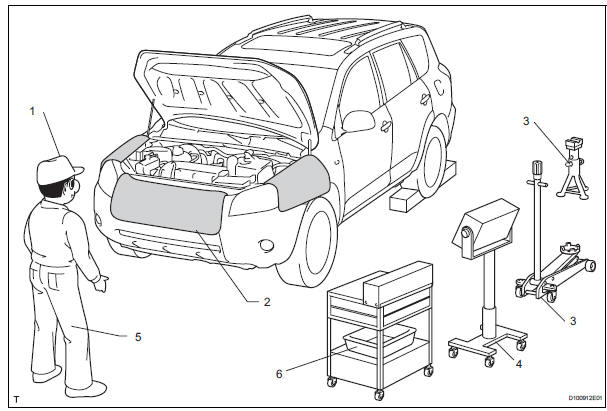
| 1 | Attire |
|
| 2 | Vehicle protection | Prepare a grille cover, fender cover, seat cover and floor mat before starting the operation. |
| 3 | Safe operation |
|
| 4 | Preparation of tools and measuring gauge | Before starting the operation, prepare a tool stand, sst, gauge, oil and parts for replacement. |
| 5 | Removal and installation, disassembly and assembly operations |
|
| 6 | Removed parts |
|
- Jacking up and supporting vehicle
- Care must be taken when jacking up and supporting the vehicle. Be sure to lift and support the vehicle at the proper locations.
- Precoated parts
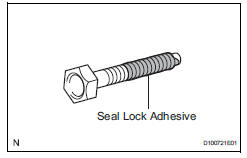
- Precoated parts are bolts and nuts that are coated with a seal lock adhesive at the factory.
- If a precoated part is retightened, loosened or moved in any way, it must be recoated with the specified adhesive.
- When reusing a precoated part, clean off the old
adhesive and dry the part with compressed air.
Then apply new seal lock adhesive appropriate to that part.
- Some seal lock agents harden slowly. You may have to wait for the seal lock adhesive to harden.
- Gaskets
- When necessary, use a sealer on gaskets to prevent leaks.
- Bolts, nuts and screws
- Carefully follow all the specifications for tightening torques. Always use a torque wrench.
- Fuses
- When inspecting a fuse, check that the wire of the fuse is not broken.
- When replacing fuses, be sure that the new fuse has the correct amperage rating. Do not exceed the rating or use one with a lower rating.


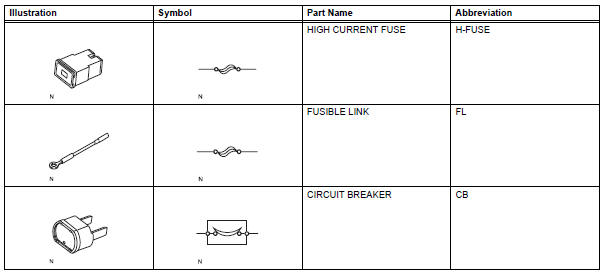
- Clips
Hint:
If clips are damaged during a procedure, always replace the clips with new clips.
- The removal and installation methods of typical clips used for vehicle body parts are shown in the table below.


- Claws
- The removal and installation methods of typical claws used for vehicle body parts are shown in the table below.
Hint:
If claws of caps or covers are damaged during a procedure, always replace the caps or covers with new ones.
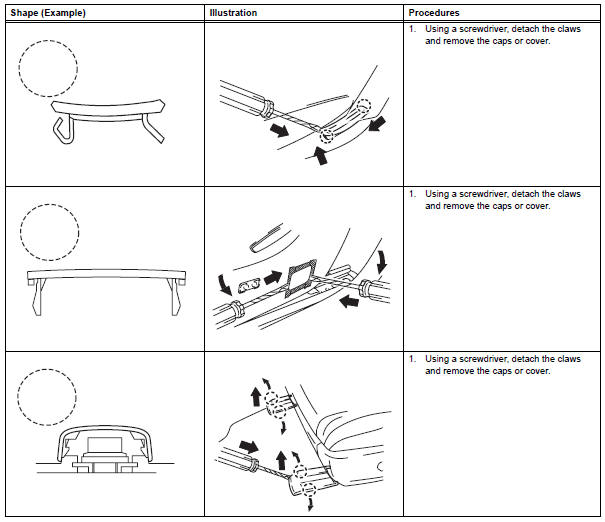

- Removal and installation of vacuum hoses.
- To disconnect a vacuum hose, pull and twist from the end of the hose. Do not pull from the middle of the hose as this may cause damage.

- When disconnecting vacuum hoses, use tags to identify where they should be reconnected.
- After completing any hose related repairs, double-check that the vacuum hoses are properly connected. The label under the hood shows the proper layout.
- When using a vacuum gauge, never force the hose onto a connector that is too large. If a hose has been stretched, it may leak air. Use a stepdown adapter if necessary.
- Torque when using torque wrench with extension tool
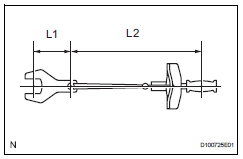

- Use the formula below to calculate special torque values for situations where sst or an extension tool is combined with a torque wrench.
Formula: t' = l2 / (l1 + l2) * t

Notice:
If an extension tool or sst is combined with a torque wrench and the wrench is used to tighten to a torque specification in this manual, the actual torque will be excessive and parts will be damaged.
 Precaution
Precaution
...
 For vehicles with supplemental restraint system
For vehicles with supplemental restraint system
The rav4 is equipped with a supplemental restraint
system (srs). The srs of this vehicle consists of the
following:
Steering pad
Front passenger airbag assembly
Front seat side airbag assemb ...
Other materials:
On-vehicle inspection
Notice:
Perform the maf meter inspection according to the
procedures below.
Only replace the maf meter when both the long
ft#1 value and maf value in the data list (with the
engine stopped) are not within the normal operating
range.
Inspect mass air flow meter
Perform c ...
Removal
Disconnect cable from negative battery
terminal
Caution:
Wait at least 90 seconds after disconnecting the
cable from the negative (-) battery terminal to
prevent airbag and seat belt pretensioner activation.
Remove front fender liner lh
Remove front fender liner lh
Remove the ...
Wiper insert replacement
When replacing the wiper
insert, perform the following
procedure to operate each
wiper.
Windshield wipers
â– Windshield wiper blade
removal and installation
1. While holding the hook portion A
of the wiper arm, first
lift up the driver side, and
then lift up the passenger
side.
When returning the ...
